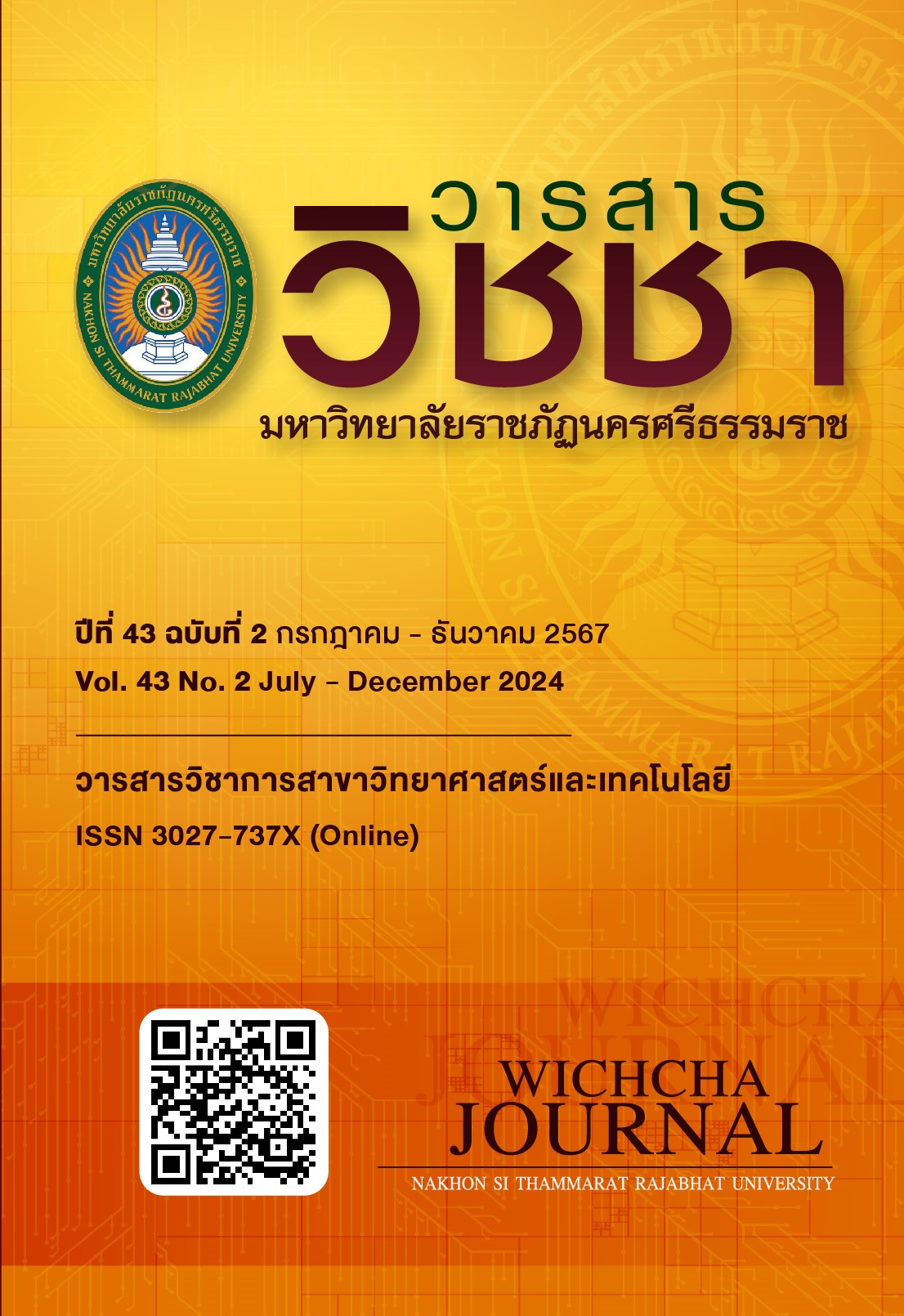The Study of Primary Macronutrients from the Dung and Compost of the Xylotrupes gideon
Main Article Content
Abstract
This research aimed to study the plant nutrients from the Xylotrupes gideon dung by feeding different main constituent diets, such as sawdust (dung 1) and corncob (dung 2), and compost from two types of the X. gideon dung. The compost was used with effective microorganisms (EM) and an anaerobic fermentation process. The macronutrients of plants, nitrogen (N), phosphorus (P), and potassium (K) were analyzed. It was found that the dung 1 and the dung 2 showed a quantity of nitrogen lower than the criteria set by the department of agriculture (not less than 1.00% by weight) with 0.22 and 0.46 percent, respectively. Moreover, the nitrogen and phosphorus nutrient content of the dung 2 were higher than the dung 1, while the potassium nutrient content was similar, 0.97%by weight (%wt) for the dung 1 and 0.94 %wt for the dung 2. Owing to the different mineral compositions of the sawdust and corncob used to feed the X, Gideon, the corncob had a higher nitrogen and potassium content than the sawdust. For the analysis of plant essential nutrients in both compost formulations such as formula 1 and formula 2, it was found that compost formula 1 showed a nitrogen content of 1.45% and potassium content of 1.18%, which was higher than that of dung 1, dung 2, and fertilizer formula 2. The phosphorus content of formula 1 was 1.10% and formula 2 was 1.15%, which means that both compost formulas contained similar amounts of phosphorus. In this research, it can be seen that the compost contained a high number of essential macronutrients for plants when compared to other composts extensively used in agriculture. Therefore, the X. Gideon dung was a type of dung that was useful and suitable for use as compost for further agricultural purposes.
Article Details

This work is licensed under a Creative Commons Attribution-NonCommercial-NoDerivatives 4.0 International License.
เนื้อหาและข้อมูลในบทความที่ลงตีพิมพ์ในวารสารวิชชา มหาวิทยาลัยราชภัฏนครศรีธรรมราช ถือเป็นข้อคิดเห็นและความรับผิดชอบของผู้เขียนบทความโดยตรง ซึ่งกองบรรณาธิการวารสารไม่จำเป็นต้องเห็นด้วยหรือร่วมรับผิดชอบใด ๆ
บทความ ข้อมูล เนื้อหา รูปภาพ ฯลฯ ที่ได้รับการตีพิมพ์ในวารสารวิชชา มหาวิทยาลัยราชภัฏนครศรีธรรมราช ถือเป็นลิขสิทธ์ของวารสารวิชชา มหาวิทยาลัยราชภัฏนครศรีธรรมราช หากบุคคลหรือหน่วยงานใดต้องการนำข้อมูลทั้งหมดหรือส่วนหนึ่งส่วนใดไปเผยแพร่ต่อหรือเพื่อการกระทำการใด ๆ จะต้องได้รับอนุญาตเป็นลายลักษณ์อักษรจากวารสารวิชชา มหาวิทยาลัยราชภัฏนครศรีธรรมราชก่อนเท่านั้น
The content and information in the article published in Wichcha journal Nakhon Si Thammarat Rajabhat University, It is the opinion and responsibility of the author of the article. The editorial journals do not need to agree. Or share any responsibility.
References
กรมวิชาการเกษตร. (2548). ปุ๋ยอินทรีย์. กรุงเทพฯ: ชุมชนสหกรณ์การเกษตรแห่งประเทศไทย จำกัด.
กรมวิชาการเกษตร. (2551). คู่มือวิเคราะห์ปุ๋ยอินทรีย์. กรุงเทพฯ: กองวิจัยพัฒนาปัจจัยการผลิตทางการเกษตร กลุ่มวิจัยเกษตรเคมี.
กรมวิชาการเกษตร. (2553). กระบวนการวิเคราะห์ ตรวจสอบดินทางเคมี. สืบค้นเมื่อ 31 พฤษภาคม 2565, จาก: https://www.ldd.go.th/PMQA/2553/Manual/OSD-03.pdf.
นรินทร์ ตันไพบูลย์. (2563). แนวโน้มธุรกิจ/อุตสาหกรรม ปี 2563-2565: อุตสาหกรรมปุ๋ยเคมี. สืบค้นเมื่อ 7 มีนาคม 2565, จาก: https://www.krungsri.com/getmedia/b2a858e1-a2c8-41ca-bb52-203cfd50ffb0/IO_Chemical_Fertilizer_200129_TH_EX.pdf.aspx.
เผดิมศิลป์ รามศิริ. (2548). ชีววิทยาของกว่างชน กว่างซางเหนือ และกว่างสามเขาเขาใหญ่ในภาคเหนือตอนบนของประเทศไทย. วิทยานิพนธ์วิทยาศาสตรมหาบัณฑิต (สาขาวิชาชีววิทยา). มหาวิทยาลัยเชียงใหม่, เชียงใหม่.
พัชรี เดชเลย์ คมกฤษณ์ แสงเงิน ณัฐพงค์ จันจุฬา และอนันต์ พิริยะภัทรกิจ. (2565). ผลของปุ๋ยหมักจากต้นกล้วยหอมทองเสริมซีลีเนียมต่อการเจริญเติบโตผลผลิต และปริมาณซีลีเนียมของผักกาดหอม. วารสารวิชชา มหาวิทยาลัยราชภัฏนครศรีธรรมราช, 41(1), 15-23.
พิสุทธิ์ เอกอำนวย. (2552). มาเลี้ยงด้วงกัน. กรุงเทพฯ: สวนสัตว์แมลงสยาม.
วัฒนณรงค์ มากพันธ์ เกษมสันติ์ คำบุญมา และปิยะ ขวดแก้ว. (2560). ปริมาณธาตุอาหารของปุ๋ยหมักชนิดต่าง ๆ จากขยะอินทรีย์ ในมหาวิทยาลัยราชภัฏนครศรีธรรมราช. วารสารมหาวิทยาลัยทักษิณ, 20(2), 18-28.
สุภาพร รัตนาพันธุ์ ปราโมทย์ ทิมขำ เผดิมศิลป์ รามศิริ แสงแก้ว คำกวน นพรัตน์ จันทร์ไชย และนันทนา เตชนันท์. (2559). การใช้ประโยชน์จากปุ๋ยมูลหนอนด้วงกว่างชน. แก่นเกษตร, 41(3), 269-274.
Bisen, P.S., Debnath, M. and Prasad, G.B.K.S. (2012). Microbes: Concepts and applications. New Jersey: Blackwell John Wiley and Sons.
Conklin Jr, A.R. (2005). Introduction to soil chemistry: Analysis and instrumentation. (2nd ed). New Jersey: Blackwell John Wiley and Sons.
Hsu, J.H. and Lo, S.L. (2001). Effect of composting on characterization and leaching of copper, manganese, and zinc from swine manure. Environmental Pollution, 114(1), 119-127, doi: https://doi.org/10.1016/S0269-7491(00)00198-6.
Soil and Plant Analysis Council. (2000). Soil analysis: Handbook of reference methods. Florida: CRC Press.

